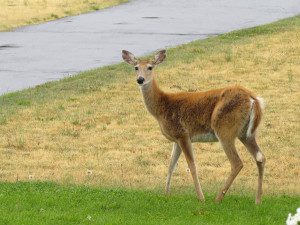Apr. 3 column: Deer

If I had a dollar for every time I’m asked about deer, I would be a wealthy gal! And I can completely relate to the folks who are asking me because it’s a frustrating topic.
I know, because we’ve had deer come into our yard over the past 25 years. My husband Bill and I have tried everything, both out of curiosity and to see what works the best. A few years ago, we finally broke down and built a deer fence. I have to admit it works GREAT!
But you might not need to go to that much trouble.
Are deer driving you — or a gardening friend — crazy? My column today is all about dealing with them. In it, I go through all of the options. These include scaring them, repelling them and creating barriers to keep them out.
I also wanted to mention that I have some videos on my YouTube channel about these annoying creatures. Be sure to check them out!
Keeping Deer Out of the Garden
by Susan Mulvihill
We gardeners get visitors of all sorts. The most frustrating and annoying ones are deer.
Deer are creatures of habit. They have certain fields or landscapes that provide them with yummy vegetation to nibble on, so they visit them often. The mama deer love to teach their kids where to eat as well.
Deer are most active between dusk and dawn. While they’re generally timid, they become bolder when stressed by drought conditions. Deer are quite adaptable so they can get used to something you’ve added to your garden to chase them away. Also, what works for one gardener might not work for another.
If you are faced with the challenge of deer, here are some suggestions:
Scare tactics often work well. If you have dogs, keeping them loose in your yard at night will keep deer out. Got a plant or shrub that deer continually feast on? Consider placing loose sheets of chicken wire on the ground around the base. They don’t like stepping on an unstable surface.
Some gardeners tie monofilament (fishing line) between trees or fence posts. When deer brush against the line, it unnerves them. You can also tie strips of white fabric or plastic sacks to trees or post. White-tailed deer raise their tails in the air when they sense danger. These white strips will serve as a warning sign to them.
The movement of wind chimes over gates or in other areas of your garden will disturb deer. There are also motion-activated sprinklers and ultrasonic deer repellants available in garden centers and online.
Deer repellents
Since deer have a keen sense of smell, repellent sprays work quite well. If you’re intending to use one around edible crops, choose one labeled for this purpose.
Barriers:
The best way to keep them out of the garden is a tall fence. And when I say tall, I mean 7 to 8 feet tall. Deer are able to jump quite high and can scale 8 feet when being chased by a predator.
Solid fences work particularly well. That’s because deer usually won’t jump over them if they can’t see what’s on the other side. However, it doesn’t matter how good your fence is if your gate is too short or left open.
A few years ago, my husband, Bill, and I decided we’d had enough of our local deer herd’s nighttime forays. We extended the height of our existing fence. We already had a 4-foot-tall field fence surrounding our orchard and garden. Bill devised a way to add on 3-and-a-half feet of heavy-duty black plastic deer fencing above the field fence. He attaching rods of rebar to the metal fence posts. It has worked great.
An alternative to tall fences:
You don’t necessarily have to build a tall fence, however. While deer are able to leap high and wide, they can’t do both at the same time. Take advantage of this. Consider building two shorter fences and spacing them about 5 feet apart. It’s difficult for deer to hop in between the fences and then hop over the second fence. This is a very successful strategy.
One last fencing option is an electrified fence. Just make sure it’s in an area where children won’t be playing and you won’t get zapped by it.
As you can see, you have to get creative when it comes to keeping deer out of the garden. Since we’re all passionate about our gardens, it’s worth it to make the effort.

